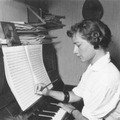Else Marie Pade facts for kids
Quick facts for kids
Else Marie Pade
|
|
|---|---|
 |
|
| Born | 2 December 1924 Aarhus, Denmark
|
| Died | 18 January 2016 (aged 91) Gentofte, Denmark
|
| Occupation | Composer, musician |
| Years active | 1952–2016 |
Else Marie Pade (born December 2, 1924 – died January 18, 2016) was a Danish composer. She was a pioneer in electronic music in Denmark. This means she was one of the first Danish composers to create music using electronic sounds.
Else Marie Pade first trained as a pianist. She studied at the Royal Danish Academy of Music in Copenhagen. Later, she learned how to compose music. In 1954, she became the first Danish composer to create electronic and concrete music. She even worked with famous composers like Pierre Schaeffer and Karlheinz Stockhausen.
Pade was also part of the Danish resistance movement during World War II. She was held in a prison camp from 1944 until the war ended.
Contents
Else Marie Pade's Early Life
Else Marie Pade was born in Aarhus, Denmark. When she was a child, she was often sick and had to stay in bed. During this time, she would listen carefully to sounds from outside. She imagined these sounds as "aural pictures" or sound images. These real-world sounds later became important in her music.
Else Marie started learning piano at home. Later, she went to the People's Music School in Aarhus. There, she discovered jazz music. Around age 16, she played in a jazz band called "The Blue Star Band." They performed at school dances and other events.
Joining the Resistance Movement
Else Marie Pade joined the Danish resistance movement through her piano teacher, Karin Brieg. One day, Else Marie showed her dislike for the German soldiers in Aarhus. A soldier chased her, but she escaped and went to Brieg's home. Brieg told her that if she wanted to resist, she should join the movement. So, Else Marie joined a women's group.
Resistance and Imprisonment During World War II
Else Marie Pade started helping the resistance by giving out secret newspapers in 1943. In 1944, she learned how to use weapons and explosives. She joined a group of women who planned to blow up telephone cables in Aarhus. This was meant to stop the Germans from using the phone network when the British invasion happened. However, the plan was canceled when the Normandy landings took place.
On September 13, 1944, the Gestapo (German secret police) arrested Pade. While in prison, she saw a star flash and heard music in her mind. The next morning, she scratched the tune into her cell wall. It was a song called "You and I and the Stars."
She was then sent to Frøslevlejren, a prison camp. There, she decided to become a composer. The prisoners in Frøslevlejren held singing evenings to keep their spirits up. These evenings included songs by Pade and others. These songs were later released on a CD called Songs in the Darkness.
Else Marie Pade's Composing Career
After the war, Else Marie Pade went to the Conservatory of Music. She first studied to be a pianist. But because of her time in the prison camp, she couldn't continue playing piano. So, she decided to train as a composer instead.
In 1952, she heard a radio show about Musique concrète and its creator, Pierre Schaeffer. This type of music uses recorded sounds from the real world. It reminded her of her own childhood experiences with sounds. She contacted Schaeffer and got the chance to visit his studio in France. She also read his book about concrete music.
Denmark's First Electronic Music
Inspired by Pierre Schaeffer, Else Marie Pade created Denmark's first concrete and electronic music piece. It was called A Day at Dyrehavsbakken. She made background music for a new Danish TV show. For this, she recorded many sounds from Dyrehavsbakken, a famous amusement park. Technicians from the radio station helped her.
Symphonie magnétophonique
This piece of music is a musique concrète work. It describes a typical day in Copenhagen. It starts with the sounds of morning, then moving to work, and finally returning home in the evening. It tells a story through everyday sounds.
Seven Circles
Else Marie Pade composed Seven Circles after visiting a planetarium at an exhibition in Brussels. This music describes the night sky, showing the stars and how they move. The piece uses ideas from other famous composers like György Ligeti, Pierre Boulez, and Karlheinz Stockhausen.
Studying New Music in Darmstadt
Else Marie Pade was very interested in new kinds of music. She traveled to Darmstadt, Germany, many times to attend special courses. There, she learned from composers like Stockhausen, Ligeti, and Boulez. She went in 1962, 1964, 1968, and 1972. Stockhausen even used her piece Glass Bead Game as an example when he taught about electronic music.
Grass Blade Ballet
Else Marie Pade became friends with dancer Nini Theilade. They met at an apartment where many artists gathered. Together, they created a TV ballet called Grass Blade. It was based on a poem and had choreography by Theilade.
Images for kids
See also
 In Spanish: Else Marie Pade para niños
In Spanish: Else Marie Pade para niños




